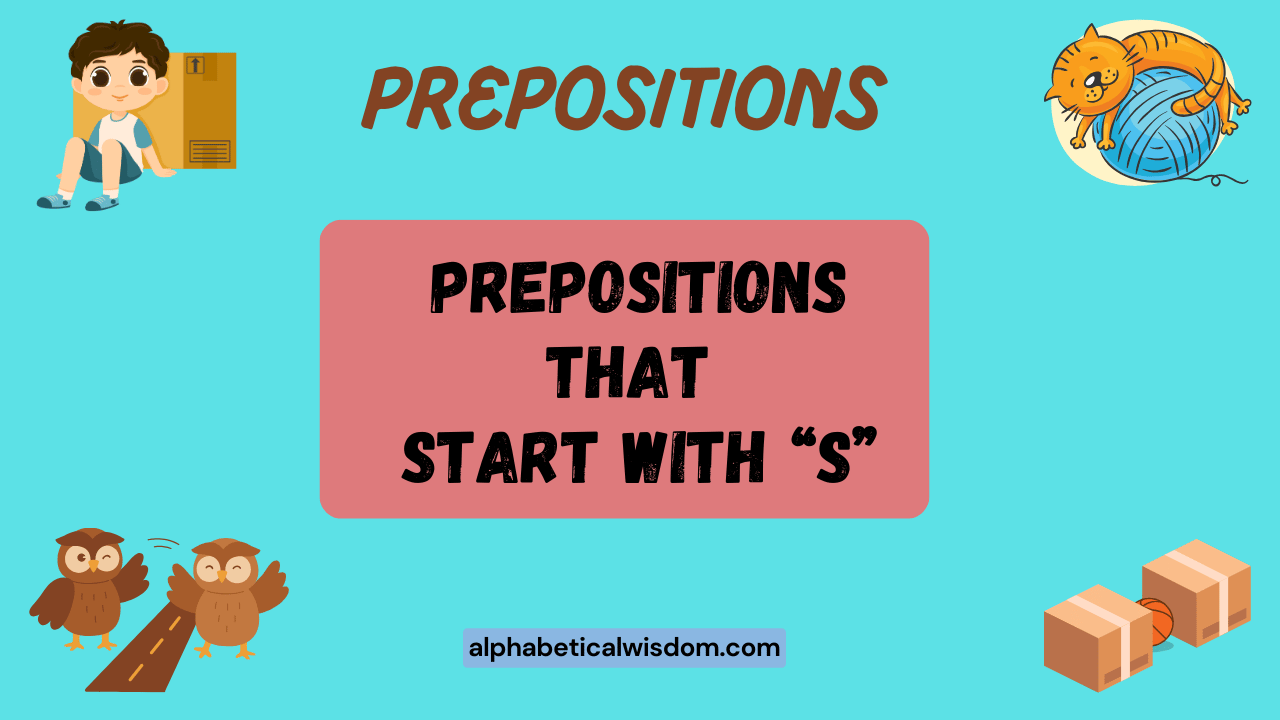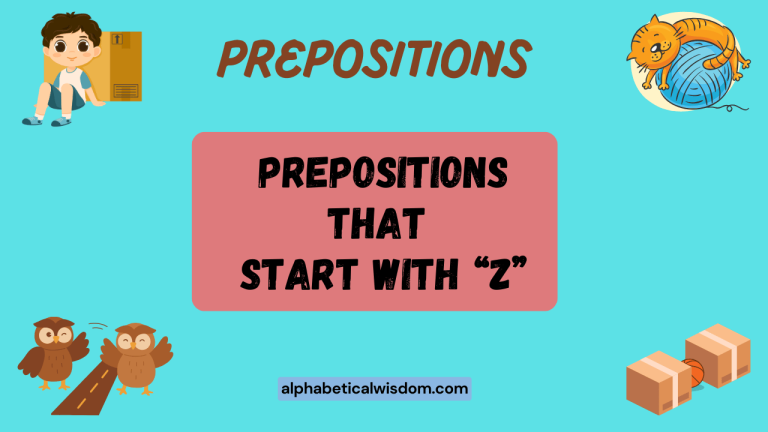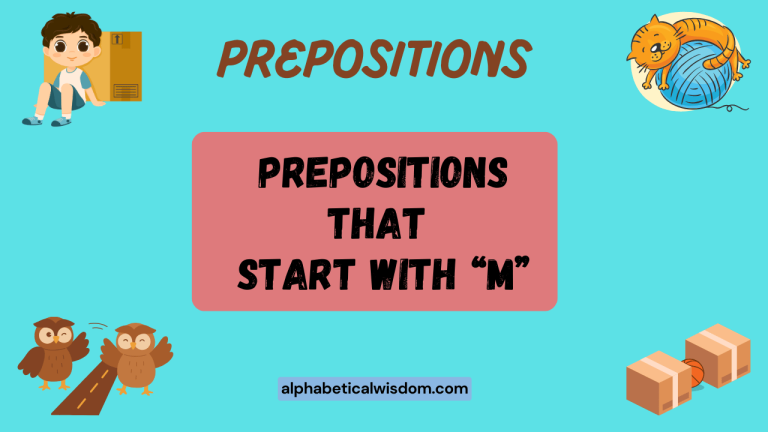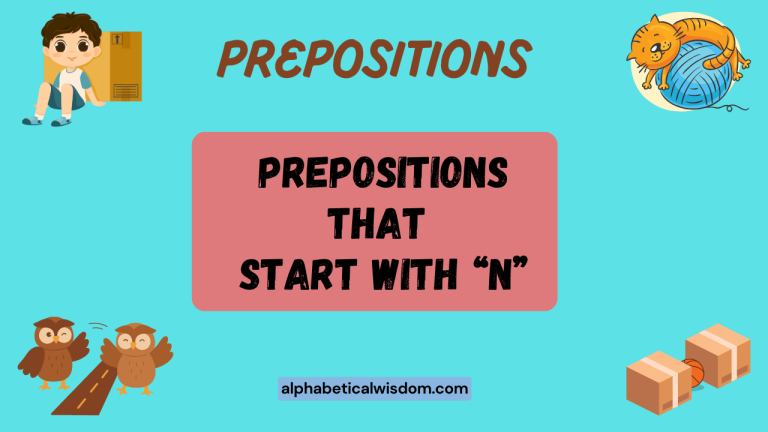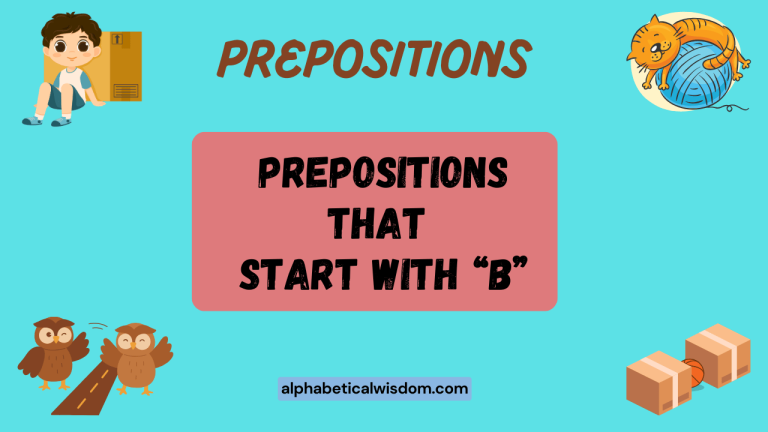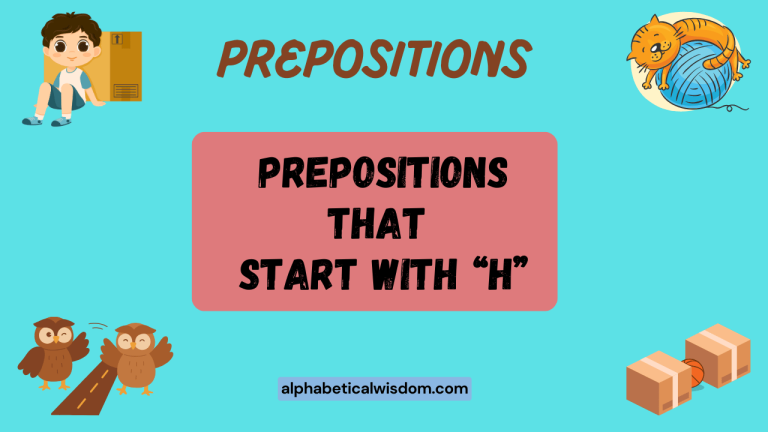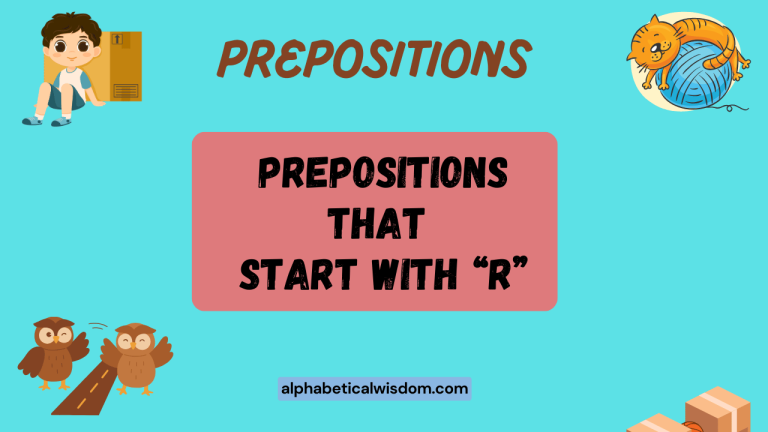Mastering Prepositions Starting With ‘S’: A Comprehensive Guide
Prepositions are essential components of the English language, acting as bridges that connect nouns, pronouns, and phrases to other parts of a sentence. They provide crucial information about location, time, direction, and relationships.
While many prepositions are commonly used, those starting with the letter ‘S’ can sometimes pose a challenge for English language learners. Understanding these prepositions is vital for constructing clear, accurate, and nuanced sentences.
This guide provides a comprehensive overview of prepositions starting with ‘S’, offering definitions, examples, usage rules, and practice exercises to help you master their use.
This article is designed for English language learners of all levels, from beginners to advanced speakers. Whether you are preparing for an English proficiency exam, writing an academic paper, or simply aiming to improve your everyday communication, this guide will equip you with the knowledge and skills needed to confidently use prepositions starting with ‘S’.
By exploring their various functions and contexts, you will gain a deeper understanding of English grammar and enhance your ability to express yourself effectively.
Table of Contents
- Definition of Prepositions Starting With ‘S’
- Structural Breakdown
- Types and Categories
- Examples
- Usage Rules
- Common Mistakes
- Practice Exercises
- Advanced Topics
- FAQ
- Conclusion
Definition of Prepositions Starting With ‘S’
A preposition is a word that connects a noun, pronoun, or noun phrase to other words in a sentence. It typically indicates the relationship between the noun or pronoun and other elements, often expressing location, direction, time, or manner.
Prepositions starting with ‘S’ function in the same way, establishing these relationships with specific nuances. These prepositions are crucial for building context and clarity in sentences, guiding the reader or listener to a deeper understanding of the intended meaning.
Prepositions are classified as a closed word class, meaning that new prepositions are rarely added to the language. They are function words, serving a grammatical purpose rather than carrying significant lexical content on their own.
Understanding the function of prepositions, particularly those starting with ‘S’, is key to mastering English grammar and improving overall communication skills.
Structural Breakdown
Prepositions, including those starting with ‘S’, typically precede a noun or pronoun, forming a prepositional phrase. This phrase consists of the preposition and its object, which is the noun or pronoun that the preposition relates to.
The prepositional phrase can then function as an adjective or adverb, modifying other words or phrases in the sentence. The structure is generally:
Preposition + (Optional Modifiers) + Noun/Pronoun
For example, in the sentence “The book is sitting on the shelf,” the preposition ‘on’ is followed by the noun ‘shelf’, forming the prepositional phrase ‘on the shelf’. This phrase acts as an adverb, modifying the verb ‘sitting’ and indicating the location of the book. The optional modifiers can include articles (a, an, the), adjectives, or other descriptive words that add detail to the object of the preposition.
Understanding this basic structure is crucial for identifying and correctly using prepositions in sentences. It allows learners to deconstruct complex sentences and understand the relationships between different elements, ultimately improving their comprehension and writing skills.
Types and Categories
Prepositions starting with ‘S’, like all prepositions, can be categorized based on their function. The primary categories are spatial, temporal, and other prepositions that indicate various relationships.
Spatial Prepositions
Spatial prepositions indicate the location or position of something in relation to something else. They describe where things are situated in space.
Common spatial prepositions starting with ‘S’ include “since” (when used to indicate a starting point in space), “surrounding,” and “sub.” While “since” is more commonly associated with time, it can sometimes be used to denote a starting point from a physical location.
Temporal Prepositions
Temporal prepositions indicate time or duration. They describe when something happens or how long it lasts.
The most common temporal preposition starting with ‘S’ is “since,” which indicates a starting point in time.
Other Prepositions
This category includes prepositions that don’t fit neatly into the spatial or temporal categories. They express various relationships such as manner, cause, purpose, or condition.
Examples include prepositions used in phrasal verbs or idiomatic expressions.
Examples
To fully grasp the usage of prepositions starting with ‘S’, it’s essential to examine them in context. The following sections provide extensive examples of spatial, temporal, and other prepositions, illustrating their various functions and nuances.
By studying these examples, learners can develop a deeper understanding of how these prepositions contribute to the meaning and clarity of sentences.
Spatial Prepositions Examples
Although less common, the preposition “since” can sometimes imply a starting point in space, particularly when combined with other spatial cues. The preposition “surrounding” describes the area or objects around a specific point, while “sub” indicates something below or under something else.
These spatial prepositions help to define the physical relationships between objects and locations.
| Sentence | Preposition | Explanation |
|---|---|---|
| We hiked since the base of the mountain, gradually ascending. | Since | Indicates the starting point of the hike. |
| The castle had walls surrounding the entire village. | Surrounding | Describes the castle walls encircling the village. |
| The submarine is designed to operate sub the ocean surface. | Sub | Indicates the submarine’s position below the water. |
| The security guards positioned themselves surrounding the perimeter fence. | Surrounding | Describes the security guards’ placement around the fence. |
| The avalanche started since the peak of the mountain. | Since | Implies the avalanche originated from a high point. |
| The protestors marched since the city limits. | Since | Indicates the starting location of the protest march. |
| The forest fire spread, surrounding the small town within hours. | Surrounding | Describes how the fire engulfed the town. |
| The roots of the tree extended sub the ground, seeking water. | Sub | Indicates the location of the roots beneath the surface. |
| The troops advanced since the border, pushing into enemy territory. | Since | Implies the starting point of the troop’s advance. |
| The dense fog was surrounding the airport, delaying flights. | Surrounding | Describes how the fog enveloped the airport. |
| The ancient city was built sub the modern metropolis. | Sub | Indicates the ancient city’s location beneath the modern one. |
| The river flowed since the glacier, carving a path through the valley. | Since | Implies the river’s origin at the glacier. |
| The police formed a cordon surrounding the crime scene. | Surrounding | Describes the police’s containment of the area. |
| The secret bunker was located sub the main building. | Sub | Indicates the bunker’s position underneath the building. |
| The floodwaters receded since the highest point, leaving debris behind. | Since | Implies the retreat of the floodwaters from a high-water mark. |
| The paparazzi were surrounding the celebrity’s car. | Surrounding | Describes the paparazzi’s encirclement of the vehicle. |
| The hidden treasure was buried sub the old oak tree. | Sub | Indicates the treasure’s location beneath the tree. |
| The climbers started since the foothills, aiming for the summit. | Since | Implies the beginning of the climb at the base of the mountains. |
| The smoke was surrounding the burning building, making rescue difficult. | Surrounding | Describes the smoke’s envelopment of the structure. |
| The network of tunnels ran sub the entire city. | Sub | Indicates the tunnels’ location beneath the city. |
| The army advanced since the river crossing. | Since | Indicates the starting point of the army’s advance. |
| A swarm of bees was surrounding the hive. | Surrounding | Describes the bees’ encirclement of their home. |
| The lava flowed sub the cooled top layer of rock. | Sub | Indicates the lava’s position beneath the surface. |
Temporal Prepositions Examples
The preposition “since” is commonly used to indicate a point in time from which something has continued. It establishes a duration or period that extends from a specific moment in the past to the present.
This temporal preposition is essential for expressing ongoing states, actions, or conditions.
| Sentence | Preposition | Explanation |
|---|---|---|
| I have lived here since 2010. | Since | Indicates the starting year of living in the place. |
| She has been working on this project since last May. | Since | Indicates the starting month of working on the project. |
| They haven’t seen each other since the graduation ceremony. | Since | Indicates the event that marked the last meeting. |
| The company’s profits have increased since the new management took over. | Since | Indicates the time the new management started. |
| The city has undergone significant changes since the early 2000s. | Since | Indicates the starting period of the changes. |
| The technology has advanced rapidly since the invention of the internet. | Since | Indicates the point the internet was invented. |
| He has been studying diligently since the beginning of the semester. | Since | Indicates the semester’s start. |
| The relationship between the two countries has improved since the peace treaty. | Since | Indicates the peace treaty signing. |
| The artist has gained international recognition since his first exhibition. | Since | Indicates the first exhibition. |
| The team has been practicing relentlessly since their last defeat. | Since | Indicates the last defeat. |
| The old house has been abandoned since the storm. | Since | Indicates the storm event. |
| The law has been in effect since the first of the year. | Since | Indicates the year’s start. |
| The garden has flourished since the heavy rains. | Since | Indicates the rain’s start. |
| The price of oil has fluctuated since the political unrest. | Since | Indicates the unrest start. |
| The town has grown significantly since the new factory opened. | Since | Indicates factory opening. |
| The band has been touring non-stop since the release of their album. | Since | Indicates start of album release. |
| The patient has been recovering steadily since the surgery. | Since | Indicates surgery start. |
| The company’s stock has performed well since the merger. | Since | Indicates merger start. |
| The research project has been ongoing since 2021. | Since | Indicates the start of the project. |
| The tradition has been upheld since the founding of the community. | Since | Indicates the community start. |
| The museum has been open to the public since 1950. | Since | Indicates the start date of the museum. |
| The population has been steadily rising since 1990. | Since | Indicates the start date of population increase. |
| The climate has been changing since the industrial revolution. | Since | Indicates the start of change in climate. |
Other Prepositions Examples
While less common, prepositions starting with “S” can also appear in other contexts, often within phrasal verbs or idiomatic expressions. These usages may not fit neatly into spatial or temporal categories but still serve to connect elements within a sentence.
Understanding these diverse applications of prepositions starting with “S” can enhance one’s grasp of the English language.
| Sentence | Preposition | Explanation |
|---|---|---|
| The solution spun off from the original research. | Off | Part of the phrasal verb “spun off,” indicating a derivative. |
| She stood by her principles. | By | Even though the preposition does not start with “S”, it is showing an example of other prepositions. |
| He succeeded in his endeavors. | In | Even though the preposition does not start with “S”, it is showing an example of other prepositions. |
| The company struggled through the recession. | Through | Even though the preposition does not start with “S”, it is showing an example of other prepositions. |
| They settled on a compromise. | On | Even though the preposition does not start with “S”, it is showing an example of other prepositions. |
| The project suffered from a lack of funding. | From | Even though the preposition does not start with “S”, it is showing an example of other prepositions. |
| The team strived for excellence. | For | Even though the preposition does not start with “S”, it is showing an example of other prepositions. |
| She specialized in ancient history. | In | Even though the preposition does not start with “S”, it is showing an example of other prepositions. |
| He speculated about the future. | About | Even though the preposition does not start with “S”, it is showing an example of other prepositions. |
| The artist sought after fame and recognition. | After | Even though the preposition does not start with “S”, it is showing an example of other prepositions. |
| The government struggled against corruption. | Against | Even though the preposition does not start with “S”, it is showing an example of other prepositions. |
| They succeeded despite the odds. | Despite | Even though the preposition does not start with “S”, it is showing an example of other prepositions. |
| The company suffered under the new regulations. | Under | Even though the preposition does not start with “S”, it is showing an example of other prepositions. |
| The scientist speculated on the origins of the universe. | On | Even though the preposition does not start with “S”, it is showing an example of other prepositions. |
| The athlete strived towards perfection. | Towards | Even though the preposition does not start with “S”, it is showing an example of other prepositions. |
| The detective specialized in solving cold cases. | In | Even though the preposition does not start with “S”, it is showing an example of other prepositions. |
| The politician sought for support from the public. | For | Even though the preposition does not start with “S”, it is showing an example of other prepositions. |
| The country struggled with poverty and inequality. | With | Even though the preposition does not start with “S”, it is showing an example of other prepositions. |
Usage Rules
Using prepositions correctly involves understanding their specific meanings and the contexts in which they are appropriate. For “since,” the key rule is to use it to indicate a starting point in time or, less commonly, in space.
The verb tense in the main clause often needs to be in a perfect tense (e.g., present perfect, past perfect) to reflect the ongoing nature of the action or state. When using “surrounding,” ensure that the noun following it accurately represents the area or objects that encircle the subject.
For “sub,” be precise in indicating what is located beneath or under something else.
It’s important to pay attention to the specific nuances of each preposition and how it affects the overall meaning of the sentence. Incorrect usage can lead to confusion or misinterpretation.
By carefully considering the context and applying these rules, learners can improve the accuracy and clarity of their writing and speaking.
Common Mistakes
One common mistake is using “since” with a simple past tense when a perfect tense is required. For example, saying “I lived here since 2010” is incorrect; the correct form is “I have lived here since 2010.” Another error is misusing “surrounding” to describe something that is only partially around something else.
Ensure that “surrounding” accurately conveys the idea of encirclement. With “sub,” a frequent mistake is using it interchangeably with “under” without considering the specific context.
“Sub” often implies a more technical or formal usage, particularly in scientific or engineering contexts.
Being aware of these common errors and actively working to avoid them is crucial for mastering prepositions starting with ‘S’. By reviewing examples of correct and incorrect usage, learners can reinforce their understanding and improve their accuracy in using these prepositions.
| Incorrect | Correct |
|---|---|
| I lived here since 2010. | I have lived here since 2010. |
| The fence was surrounding the house (when it only covered one side). | The fence was along one side of the house. |
Practice Exercises
These exercises will help you practice using prepositions starting with ‘S’. Fill in the blanks with the correct preposition, correct the errors in the sentences, and complete the sentences with appropriate phrases.
Exercise 1: Fill in the Blanks
Complete the following sentences with the correct preposition (since, surrounding, sub).
| Question | Answer |
|---|---|
| The company has been profitable ______ its inception. | since |
| The mountains ______ the valley provide a beautiful backdrop. | surrounding |
| The divers explored the area ______ the sunken ship. | sub |
| The town has changed a lot ______ I was a child. | since |
| The guards were positioned ______ the building. | surrounding |
| The secret base was located ______ the ice. | sub |
| The project has been underway ______ January. | since |
| The forest was dense and green, ______ the lake. | surrounding |
| The old mine was found ______ the surface. | sub |
| The city has grown ______ the new development was built. | since |
Exercise 2: Error Correction
Identify and correct the errors in the following sentences.
| Question | Answer |
|---|---|
| I live here since 2015. | I have lived here since 2015. |
| The park was surrounding by trees (when it was only partially enclosed). | The park was bordered by trees. |
| She worked here since a long time. | She has worked here since a long time. OR She worked here for a long time. |
| The building is surround by a fence. | The building is surrounded by a fence. |
| He is studying since last year. | He has been studying since last year. |
Exercise 3: Sentence Completion
Complete the following sentences using prepositions starting with S.
| Question | Answer |
|---|---|
| ______ the beginning of the movie, I was captivated. | Since |
| The island, ______ by crystal-clear waters, was a paradise. | surrounding |
| The hidden chamber, ______ the main hall, contained ancient artifacts. | sub |
| ______ the new law was enacted, crime rates have decreased. | Since |
| The fortress, ______ by high walls and towers, was impenetrable. | surrounding |
Advanced Topics
For advanced learners, exploring the etymology of prepositions starting with ‘S’ can provide a deeper understanding of their nuances. Understanding how these words have evolved over time can shed light on their current usage.
Additionally, analyzing the use of these prepositions in literature and formal writing can enhance one’s ability to appreciate and emulate sophisticated language. Advanced learners can also focus on mastering idiomatic expressions and phrasal verbs that incorporate these prepositions, as these often have meanings that are not immediately obvious from the individual words.
Furthermore, comparing the usage of prepositions starting with ‘S’ in different dialects of English can reveal subtle variations and regional preferences. This can be particularly useful for learners who aim to achieve a high level of proficiency and cultural awareness.
FAQ
- What is the main function of a preposition?
A preposition connects a noun, pronoun, or noun phrase to other words in a sentence, indicating relationships of location, time, direction, or manner.
- How do I know which preposition to use?
Consider the specific relationship you want to express and choose the preposition that best conveys that meaning. Pay attention to the context and the nuances of each preposition.
- Can a preposition come at the end of a sentence?
Yes, it is grammatically acceptable, particularly in informal contexts. However, in formal writing, it is often preferable to rephrase the sentence to avoid ending with a preposition.
- What is a prepositional phrase?
A prepositional phrase consists of a preposition and its object (a noun or pronoun), along with any modifiers. It functions as an adjective or adverb in the sentence.
- Is “since” only used for time?
While “since” is primarily used to indicate a starting point in time, it can also be used to indicate a starting point in space, though this usage is less common.
- What are some common mistakes people make with prepositions?
Common mistakes include using the wrong preposition for the intended meaning, omitting prepositions when they are needed, and using incorrect verb tenses with prepositions like “since.”
- How can I improve my preposition usage?
Practice regularly by reading and writing in English. Pay attention to how native speakers use prepositions and make note of any patterns or rules you observe. Use online resources and grammar guides to reinforce your understanding.
- Are there any prepositions starting with ‘S’ that are commonly confused with other words?
The preposition “since” can be confused with the conjunction “since,” which introduces a clause. The difference lies in their function: the preposition is followed by a noun or pronoun, while the conjunction is followed by a clause with a subject and verb.
- Can you give more examples of how “since” is used in different tenses?
Certainly! Here are a few more examples showcasing different tenses with “since”:
- Present Perfect: “They have been friends since childhood.”
- Past Perfect: “She had been studying French since she was ten years old.”
- Present Perfect Continuous: “He has been working on this project since last summer.”
- How do I know when to use “sub” versus “under”?
“Sub” is often used in more technical or formal contexts to indicate something beneath or below, particularly in scientific or engineering fields. “Under” is a more general term that can be used in a wider range of situations. For example, you might say “The submarine is sub the surface” in a technical report, but you would more commonly say “The cat is under the table” in everyday conversation.
Conclusion
Mastering prepositions starting with ‘S’ is a crucial step in achieving fluency and accuracy in English. By understanding their definitions, structural roles, and usage rules, learners can confidently incorporate these prepositions into their writing and speaking.
This guide has provided a comprehensive overview of spatial, temporal, and other prepositions starting with ‘S’, along with examples, practice exercises, and tips for avoiding common mistakes. Remember that consistent practice and attention to detail are key to mastering any aspect of grammar.
Continue to explore the nuances of English grammar and seek opportunities to apply your knowledge in real-world contexts. With dedication and perseverance, you can achieve your goals and become a proficient communicator in English.
Embrace the challenges and celebrate your progress as you continue on your language learning journey.
